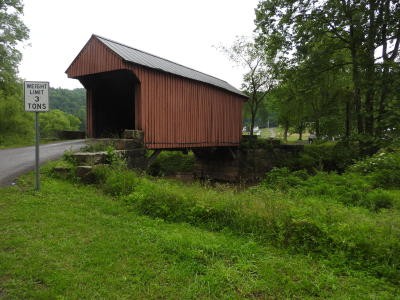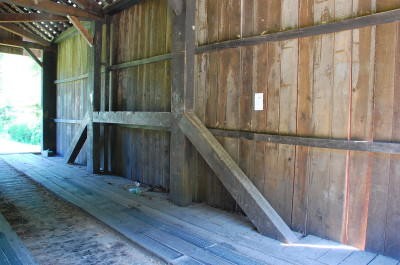Walkersville Covered Bridge
Introduction
Text-to-speech Audio
Images
Walkersville Covered Bridge

Interior view of the bridge. Note the low-profile queenpost truss

Architectural sketch of one of the trusses

Backstory and Context
Text-to-speech Audio
In June of 1902, J. E. Spriggs, G. I. Dennison, H. O. Wilson, and others petitioned the Lewis County Court for a new bridge crossing the West Fork River. The court responded by appointing W. E. Wick and W. D. Anderson as a committee to determine a location and cost of the new bridge. After a few weeks, the court acted upon on the committee’s recommendation and directed W. S. Smith to create plans for stone abutments. The original plan for the location was to erect an iron bridge. However, the court must have changed their plans as John G. Sprigg was contracted to build a wooden covered bridge in December of 1902. By March of 1903, the bridge was completed and Sprigg was paid $567 – approximately $17,000 adjusted for inflation – for his work.
The Walkersville Covered Bridge measures twelve feet wide and thirty-nine feet long. The siding is vertical board-and-batten and the structure is covered with a standing seam metal roof. The relatively short bridge makes use of a single set of queenpost trusses. This style of truss features two vertical posts each set about one-third of the way in from the end of the truss. The posts are connected by a top beam and diagonally braced against the ends of the truss. Curiously, the trusses in the Walkersville Covered Bridge have a relatively low profile. Most queenpost trusses in covered bridges extend almost to the rafters, while the trusses in the Walkersville Covered Bridge are only a few feet high.
Some small maintenance tasks were undertaken on the Walkersville Covered Bridge in 1984, but it was not until 2002 that a more extensive restoration occurred. Allegheny Restoration and Builders, Inc. were given a $230,859 contract to replace the siding and shore up some support components of the bridge. Despite the restorations, the Walkersville Covered Bridge remains largely unmodified from its original design. This is particularly significant as the bridge still accommodates vehicle traffic. In addition, the bridge is the only extant covered bridge in Lewis County
Sources
Hanson, Todd A. Covered Bridges, The West Virginia Encyclopedia. May 28th 2019. Accessed August 20th 2020. https://www.wvencyclopedia.org/articles/1660.
KCI Technologies, Inc and Mead & Hunt, Inc. West Virginia Statewide Historic Bridge Survey: Final Survey Report, Highways Through History. April 1st 2015. Accessed August 20th 2020. https://www.highwaysthroughhistory.com/Content/bridges/WVSHBSFinalSurveyReport.pdf.
Kemp, E L. Walkersville Covered Bridge, National Register of Historic Places. June 4th 1981. Accessed August 20th 2020. http://www.wvculture.org/shpo/nr/pdf/lewis/81000603.pdf.
McKee, Brian, et al. Walkersville Covered Bridge, Bridge Hunters. November 14th 2019. Accessed August 20th 2020. https://bridgehunter.com/wv/lewis/walkersville-covered/.
Walkersville Covered Bridge, West Virginia Department of Transportation. Accessed August 20th 2020. https://transportation.wv.gov/highways/bridge_facts/covered-bridges/Pages/WalkersvilleCoveredBridge.aspx.
Jack Schmidt
Brian McKee
E. L. Kemp
